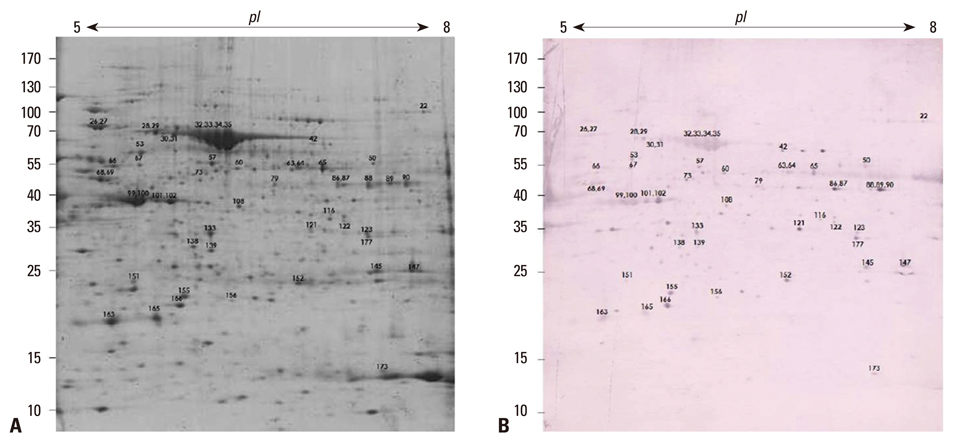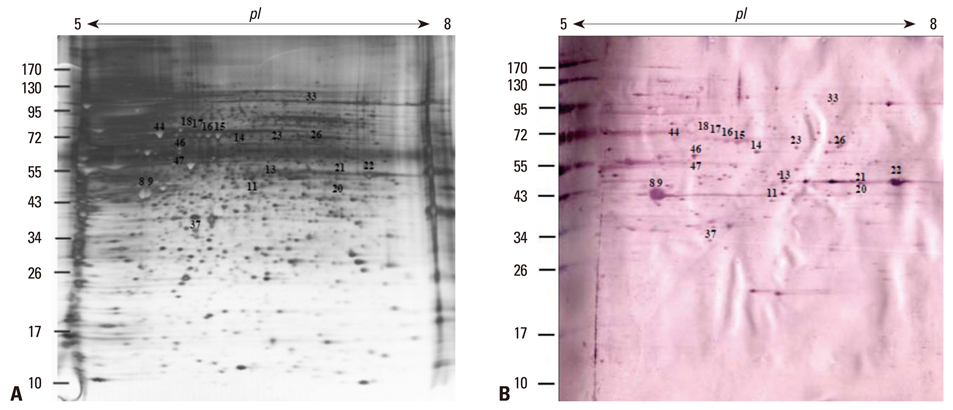Yonsei Med J.
2013 Nov;54(6):1342-1352. 10.3349/ymj.2013.54.6.1342.
Gastric Autoantigenic Proteins in Helicobacter Pylori Infection
- Affiliations
-
- 1Department of Pediatrics, Gyeongsang National University School of Medicine, Gyeongsang Institute of Health Science, Jinju, Korea. hsyoun@gnu.ac.kr
- 2Department of Internal Medicine, Gyeongsang National University School of Medicine, Gyeongsang Institute of Health Science, Jinju, Korea.
- 3Department of Pathology, Gyeongsang National University School of Medicine, Gyeongsang Institute of Health Science, Jinju, Korea.
- 4Department of Microbiology, Gyeongsang National University School of Medicine, Gyeongsang Institute of Health Science, Jinju, Korea.
- KMID: 1798129
- DOI: http://doi.org/10.3349/ymj.2013.54.6.1342
Abstract
- PURPOSE
This study tried to identify novel gastric autoimmune antigens that might be involved in aggravating the atrophic gastritis among patients with Helicobacter pylori infection using two-dimensional immunoblotting analysis.
MATERIALS AND METHODS
Proteins from gastric mucosal antrectomy specimens and AGS cells (gastric adenocarcinoma cell lines derived from a Caucasian patient who had received no prior therapy) were 2-dimensionally immunoblotted separately with a pool of 300 sera from H. pylroi-infected patients at Gyeongsang National University Hospital.
RESULTS
Thirty-eight autoantigenic proteins including alcohol dehydrogenase [NADP+], alpha enolase, gastrokine-1, gastric triacylglycerol lipase, heat shock 70 kDa protein 1, and peroxiredoxin-2 were identified in the gastric mucosal tissue. Fourteen autoantigenic proteins including programmed cell death 6-interacting protein, serum albumin and T-complex protein 1 subunit gamma were identified in the AGS cells. Albumin, alpha-enolase, annexin A3, cytoplasmic actin 1, heat shock cognate 71 kDa protein and leukocyte elastase inhibitor were commonly observed autoantigenic proteins in both gastric mucosal tissue and AGS cells. Alpha-enolase, glutathione S-transferase P, heat shock cognate 71 kDa protein, heat shock 70 kDa protein 1, human mitochondrial adenosine triphosphate synthase (ATP) subunit beta, mitochondrial 60 kDa heat shock protein, peroxiredoxin-2, 78 kDa glucose-regulated protein precursor, tyrosine-protein phosphatase non-receptor type 11 and Tryptophan-Aspartic acid (WD) repeat-containing protein 1 showed 60% or higher amino acid positivity.
CONCLUSION
These newly identified gastric autoimmune antigens might be useful in the control and prevention of gastroduodenal disorders, and might be valuable in breaking the vicious circle that exists in gastroduodenal disorders if their pathophysiological roles could be understood in the progress of chronic atrophic gastritis, gastroduodenal ulcers, intestinal metaplasia, and gastric carcinogenesis.
MeSH Terms
-
Alcohol Dehydrogenase/metabolism
Autoantigens/*metabolism
Electrophoresis, Gel, Two-Dimensional
Gastric Mucosa/metabolism/microbiology
Helicobacter Infections/*metabolism
Humans
Peptide Hormones/metabolism
Phosphopyruvate Hydratase/metabolism
Alcohol Dehydrogenase
Autoantigens
Peptide Hormones
Phosphopyruvate Hydratase
Figure
Reference
-
1. Korman MG, Strickland RG, Hansky J. Serum gastrin in chronic gastritis. Br Med J. 1971; 2:16–18.
Article2. Strickland RG. Gastritis. Springer Semin Immunopathol. 1990; 12:203–217.
Article3. Marshall BJ, Warren JR. Unindentified curved bacilli in the stomach of patients with gastritis and peptic ulceration. Lancet. 1984; 1:1311–1315.4. Goodwin CS, Armstrong JA, Marshall BJ. Campylobacter pyloridis, gastritis, and peptic ulceration. J Clin Pathol. 1986; 39:353–365.
Article5. Parsonnet J, Vandersteen D, Goates J, Sibley RK, Pritikin J, Chang Y. Helicobacter pylori infection in intestinal- and diffuse-type gastric adenocarcinomas. J Natl Cancer Inst. 1991; 83:640–643.
Article6. Enno A, O'Rourke JL, Howlett CR, Jack A, Dixon MF, Lee A. MALToma-like lesions in the murine gastric mucosa after long-term infection with Helicobacter felis. A mouse model of Helicobacter pylori-induced gastric lymphoma. Am J Pathol. 1995; 147:217–222.7. Correa P. Human gastric carcinogenesis: a multistep and multifactorial process--First American Cancer Society Award Lecture on Cancer Epidemiology and Prevention. Cancer Res. 1992; 52:6735–6740.8. Baik SC, Youn HS, Chung MH, Lee WK, Cho MJ, Ko GH, et al. Increased oxidative DNA damage in Helicobacter pylori-infected human gastric mucosa. Cancer Res. 1996; 56:1279–1282.9. Negrini R, Savio A, Appelmelk BJ. Autoantibodies to gastric mucosa in Helicobacter pylori infection. Helicobacter. 1997; 2:Suppl 1. S13–S16.
Article10. Kirchner T, Steininger H, Faller G. Immunopathology of Helicobacter pylori gastritis. Digestion. 1997; 58:Suppl 1. 14–16.11. Youn HS, Ko GH, Chung MH, Lee WK, Cho MJ, Rhee KH. Pathogenesis and prevention of stomach cancer. J Korean Med Sci. 1996; 11:373–385.
Article12. D'Elios MM, Appelmelk BJ, Amedei A, Bergman MP, Del Prete G. Gastric autoimmunity: the role of Helicobacter pylori and molecular mimicry. Trends Mol Med. 2004; 10:316–323.13. Baik SC, Kim JB, Cho MJ, Kim YC, Park CK, Ryou HH, et al. Prevalence of Helicobacter pylori infection among normal Korean adults. J Korean Soc Microbiol. 1990; 25:455–462.14. Rhee KH, Youn HS, Baik SC, Lee WK, Cho MJ, Choi HJ, et al. Prevalence of Helicobacter pylori Infection in Korea. J Korean Soc Microbiol. 1990; 25:475–490.15. Faller G, Steininger H, Appelmelk B, Kirchner T. Evidence of novel pathogenic pathways for the formation of antigastric autoantibodies in Helicobacter pylori gastritis. J Clin Pathol. 1998; 51:244–245.
Article16. Faller G, Kirchner T. Role of antigastric autoantibodies in chronic Helicobacter pylori infection. Microsc Res Tech. 2000; 48:321–326.
Article17. Heukeshoven J, Dernick R. Improved silver staining procedure for fast staining in PhastSystem Development Unit. I. Staining of sodium dodecyl sulfate gels. Electrophoresis. 1988; 9:28–32.
Article18. O'Connell KL, Stults JT. Identification of mouse liver proteins on two-dimensional electrophoresis gels by matrix-assisted laser desorption/ionization mass spectrometry of in situ enzymatic digests. Electrophoresis. 1997; 18:349–359.19. Ko GH, Park HB, Shin MK, Park CK, Lee JH, Youn HS, et al. Monoclonal antibodies against Helicobacter pylori cross-react with human tissue. Helicobacter. 1997; 2:210–215.
Article20. Guarneri F, Guarneri C, Benvenga S. Helicobacter pylori and autoimmune pancreatitis: role of carbonic anhydrase via molecular mimicry? J Cell Mol Med. 2005; 9:741–744.
Article21. Birnie DH, Holme ER, McKay IC, Hood S, McColl KE, Hillis WS. Association between antibodies to heat shock protein 65 and coronary atherosclerosis. Possible mechanism of action of Helicobacter pylori and other bacterial infections in increasing cardiovascular risk. Eur Heart J. 1998; 19:387–394.
Article22. Matsuura E, Kobayashi K, Matsunami Y, Shen L, Quan N, Makarova M, et al. Autoimmunity, infectious immunity, and atherosclerosis. J Clin Immunol. 2009; 29:714–721.
Article23. Rožanković PB, Huzjan AL, Cupić H, Benčić IJ, Bašić S, Demarin V. Influence of CagA-positive Helicobacter pylori strains on atherosclerotic carotid disease. J Neurol. 2011; 258:753–761.
Article24. Bassi V, Santinelli C, Iengo A, Romano C. Identification of a correlation between Helicobacter pylori infection and Graves' disease. Helicobacter. 2010; 15:558–562.
Article25. Asahi A, Nishimoto T, Okazaki Y, Suzuki H, Masaoka T, Kawakami Y, et al. Helicobacter pylori eradication shifts monocyte Fcgamma receptor balance toward inhibitory FcgammaRIIB in immune thrombocytopenic purpura patients. J Clin Invest. 2008; 118:2939–2949.26. Migneco A, Ojetti V, Specchia L, Franceschi F, Candelli M, Mettimano M, et al. Eradication of Helicobacter pylori infection improves blood pressure values in patients affected by hypertension. Helicobacter. 2003; 8:585–589.
Article27. Aragona P, Magazzù G, Macchia G, Bartolone S, Di Pasquale G, Vitali C, et al. Presence of antibodies against Helicobacter pylori and its heat-shock protein 60 in the serum of patients with Sjögren's syndrome. J Rheumatol. 1999; 26:1306–1311.28. Negrini R, Lisato L, Cavazzini L, Maini P, Gullini S, Basso O, et al. Monoclonal antibodies for specific immunoperoxidase detection of Campylobacter pylori. Gastroenterology. 1989; 96(2 Pt 1):414–420.
Article29. Negrini R, Lisato L, Zanella I, Cavazzini L, Gullini S, Villanacci V, et al. Helicobacter pylori infection induces antibodies cross-reacting with human gastric mucosa. Gastroenterology. 1991; 101:437–445.
Article30. Appelmelk BJ, Simoons-Smit I, Negrini R, Moran AP, Aspinall GO, Forte JG, et al. Potential role of molecular mimicry between Helicobacter pylori lipopolysaccharide and host Lewis blood group antigens in autoimmunity. Infect Immun. 1996; 64:2031–2040.
Article31. Uibo R, Vorobjova T, Metsküla K, Kisand K, Wadström T, Kivik T. Association of Helicobacter pylori and gastric autoimmunity: a population-based study. FEMS Immunol Med Microbiol. 1995; 11:65–68.
Article32. Ma JY, Borch K, Sjöstrand SE, Janzon L, Mårdh S. Positive correlation between H,K-adenosine triphosphatase autoantibodies and Helicobacter pylori antibodies in patients with pernicious anemia. Scand J Gastroenterol. 1994; 29:961–965.
Article33. Dermime S, Gilham DE, Shaw DM, Davidson EJ, Meziane EK, Armstrong A, et al. Vaccine and antibody-directed T cell tumour immunotherapy. Biochim Biophys Acta. 2004; 1704:11–35.
Article34. Li WH, Zhao J, Li HY, Liu H, Li AL, Wang HX, et al. Proteomics-based identification of autoantibodies in the sera of healthy Chinese individuals from Beijing. Proteomics. 2006; 6:4781–4789.
Article35. Miled N, Canaan S, Dupuis L, Roussel A, Rivière M, Carrière F, et al. Digestive lipases: from three-dimensional structure to physiology. Biochimie. 2000; 82:973–986.
Article36. Nardone G, Rippa E, Martin G, Rocco A, Siciliano RA, Fiengo A, et al. Gastrokine 1 expression in patients with and without Helicobacter pylori infection. Dig Liver Dis. 2007; 39:122–129.
Article
- Full Text Links
- Actions
-
Cited
- CITED
-
- Close
- Share
- Similar articles
-
- Prevention of Gastric Cancer: Helicobacter pylori Treatment
- Two Cases of Gastric Stump Cancer: Possible Role of Helicobacter pylori Infection
- Immune Response to Helicobacter pylori Infection
- Prevalence of Helicobacter pylori infection in patients of peptic ulcer among Korean people
- Perspective of Helicobacter pylori Research: Molecular Pathogenesis of Helicobacter pylori Virulence Factors




